
Reading & Resources
School Administrator, September 2019
Book Reviews
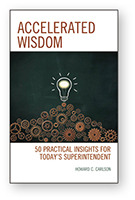 Accelerated Wisdom: 50 Practical Insights for Today’s Superintendent
Accelerated Wisdom: 50 Practical Insights for Today’s Superintendent
by Howard C. Carlson, Rowman & Littlefield, Lanham, Md., 2018, 110 pp., $25 softcover
All superintendents, as well as those who strive to become district leaders, desire wisdom. However, acquiring wisdom usually takes time thorough trial and error. In his new book,
Accelerated Wisdom, Howard Carlson provides real-world ideas to accelerate the accumulation of wisdom so readers can benefit from the experience of experienced superintendents. Carlson is a seasoned author and was voted by his peers as the Arizona Superintendent of the Year in 2018. This book is organized into seven chapters that include a brief story at the beginning of each to provide context. Presented in a concise manner, the concepts, along with specific tactics, stand alone as a helpful guide toward more effective leadership.
Accelerated Wisdom breaks down the role of the superintendent so that readers can gain from the wisdom of experienced educational leaders. For example, how can superintendents keep track of the many challenges for their time and attention? How can a leader decide on priorities and reply to requests so that people feel honored and respected? How involved should a superintendent be in recruiting, hiring and mentoring staff members? How immersed should a superintendent be in influencing legislation and local election campaigns? What role should a superintendent play in orientating new board members? How can busy school leaders manage their work and personal life in order to maintain a healthy balance? All of these questions are crucial to appreciate and master, and yet it is ordinarily only through many years of experience that superintendents find their own answers.
While the old adage, “with experience comes wisdom,” is true, it is also accurate that one can accelerate wisdom by learning from others. Leaders who are new and/or aspiring to the role of superintendent can gain insights from
Accelerated Wisdom that would normally take many years to acquire. As well, veteran superintendents will also profit from these insights because they bring the opportunity to reexamine practices and develop new strategies for success. The worksheets, templates and reflection logs that are included help bring ideas into focus. Most of the concepts provided are simple strategies that have proven to work, while others drive deeper understanding of complex issues. None of these suggestions is entirely theoretical and all have been tried and tested over a number of years.
Accelerated Wisdom provides readers the opportunity to vicariously experience a number of proven approaches to assist in the daily work of the superintendent. With 50 strategies to work with, even if only one or two makes your job better, you can count the benefits gained as a success in your career as a superintendent.
Reviewed by Jeffrey J. Smith, superintendent, Balsz Schools, Phoenix, Ariz.
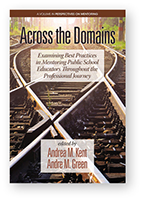 Across the Domains: Examining Best Practices in Mentoring Public School Educators Throughout the Professional Journey
Across the Domains: Examining Best Practices in Mentoring Public School Educators Throughout the Professional Journey
edited by Andrea M. Kent and
Andre M. Green, Information Age Publishing, Inc., Charlotte, N.C., 2018, 258 pp., $45.99 softcover
Being a new teacher is a daunting task and it is clear in the literature that developmentally appropriate mentoring support can be a key element toward helping new teachers survive and thrive. In
Across the Domains: Examining Best Practices in Mentoring Public School Educators Throughout the Professional Journey, Andrea Kent and Andre Green offer a fascinating and informative set of perspectives on mentoring in public school spaces. What is particularly interesting in this work is that the editors rightly consider the role of mentoring across the career spectrum, not just first-year teachers, and across different kinds of school settings. As we all know, and the editors rightly emphasize, context matters.
The editors assert that the challenge with mentoring is not that we do not know if it works. There is consensus that mentoring done well can really make a difference, indeed. The challenge, rather, is that mentoring can happen in so many different contexts (e.g., STEM fields, preservice experiences) as well as in varied formats (e.g., online, informally) and that, in these variables, there are considerable opportunities but also complex solutions. Add to that complexity the realization that the nature of the mentoring relationship is often defined by the local culture, leadership and diverse needs of the protégé, and one can easily begin to discern why the idea of mentoring can be overwhelming. Given all this variability, one is left to wonder if there is agreement on what exactly mentoring is. But it is out of this ambiguity that the editors provide clarity and precision. They affirm that mentoring can in fact be very different things to different individuals who are confronting diverse challenges. As such, there is something for almost anyone in this book.
The editors have taken these competing, and sometimes conflicting, narratives as to the nature of mentoring and placed them into coherent, instructive and relevant chapters written by practitioners and researchers. The book is thus constructed with chapters that can stand independently as their authors are addressing mentoring in a range of contexts. For example, there is a chapter on mentoring in elementary schools and another one on mentoring across cultures and yet another within an online community. School system leaders who often have many different kinds of schools, and certainly a diverse group of students and teachers, will enjoy this book as a resource for all of their teachers and leaders.
I would think central office leadership would do well to consider this book as a handbook for developing and supporting a comprehensive mentoring program. Professionally grounded in the literature with an eye for the needs of the practitioners, Kent and Green have offered an important perspective on the variability of mentoring and the value mentoring can offer adults wherever and whenever they find themselves experiencing new or innovative possibilities.
Reviewed by Zach Kelehear, vice provost for instruction and innovation, Augusta University, Augusta, Ga.
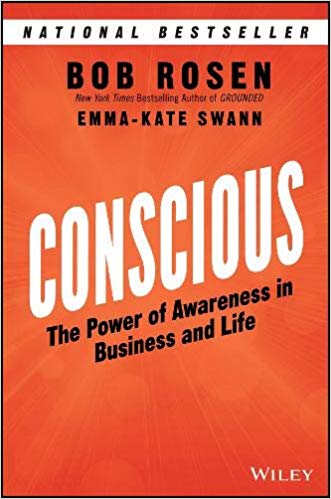 Conscious: The Power of Awareness in Business and Life
Conscious: The Power of Awareness in Business and Life
by Bob Rosen and
Emma-Kate Swann, John Wiley & Sons, Inc., Hoboken, N.J., 2018, 258 pp. with index, $26 hardcover
The world we live in is changing faster than it has ever changed before. To survive and thrive in this new world, leaders must adapt to new demands — and must adapt faster than they realize.
Conscious is both an explanation of the demands of the new world and a guide to effective strategies of adaptation. Authors Bob Rosen and Emma-Kate Swann of Healthy Companies International are mostly known for their work in developing leadership potential in business enterprises, but their ideas are appropriate for the education setting as well.
While advocates of mindfulness stress the need for leaders to step back and recharge, the emphasis of this book is to show leaders how to fully engage in their demanding work places. Full awareness of what is happening within and outside of the organization is their definition of conscious.
The authors have identified six key disruptions that have changed how we work and live
— speed, uncertainty, complexity, technology, competition and globalization. A focus on going deep, thinking big, getting real and stepping up is essential to adapting and succeeding.
The book is not just a description of the new work environment; it is filled with practical ideas that will help the reader make changes that will improve personal and organizational effectiveness. The structure of the book allows the reader to choose specific areas for attention and will serve as a handbook for guiding growth. Some ideas will be familiar to superintendents, but there is much that is new and the context for the strategies provides a coherent approach to change. Sometimes frightening, but always optimistic, the premises of
Conscious are worth exploring
Reviewed by John C. Fagan, retired superintendent, Elmhurst, Ill.
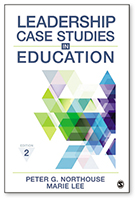
Leadership Case Studies in Education (2nd edition)
by Peter G. Northouse and Marie Lee, Sage Publishing, Thousand Oaks, Calif., 2019, 176 pp. with index, $34 softcover
Leadership Case Studies in Education is designed as a companion text to the eighth edition of Peter Northouse’s Leadership Theory and Practice. Each of the 16 chapters contains a brief description of the leadership approach and two case studies, one for the preK-12 segment of education and one for the higher education segment. At the end of each chapter, there are questions and advanced questions for discussion purposes.
Among the 16 leadership approaches, Skills Approach, Situational Approach, Path/Goal Theory Approach, Transformational Approach and Servant Leadership Approach were perhaps the most familiar.
Not having access to the companion text, I found it hard to differentiate between the different leadership approaches as the case studies sometimes included actions that could be categorized in several of the approaches. Furthermore, there was no guidance in leading discussion to the questions at the end of each chapter. It would have been helpful for the author to provide some answers or thought regarding each question.
While I enjoyed the scenarios and believed them to be useful and practical, the book is designed for graduate leadership theory classes and not pleasure reading. The chapter on gender and leadership provides useful and up-to-date information and data regarding women in the education field. Seventy-three percent of all public school teachers are female, but only 13 percent serve as superintendents. This statistic and others included certainly provides statistics for rich discussion.
Reviewed by Paul A. Shaw, director of educator ethics, Georgia Professional Standards Commission, Martin, Ga.
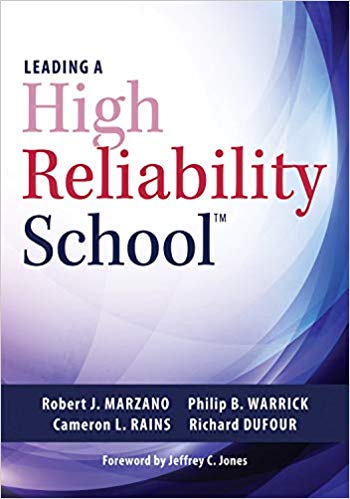
Leading a High Reliability School™
by Robert J. Marzano, Philip B. Warrick, Cameron L. Rains and Richard Dufour, Solution Tree Press, Bloomington, Ind., 2018, 199 pp. with index, $34.95 softcover
In Leading a High Reliability School™, authors Robert Marzano, Philip Warrick, Cameron Rains and Richard DuFour outline successful cultural transformation. The key lies in Professional Learning Communities at Work using a whole school or whole district effort, in which teams collaborate in recurring cycles of collective injury and action research to achieve better results for students.
Marzano is cofounder and chief academic officer of Marzano Research in Denver, Colo. During his 50 years in education, he has worked with educators as a speaker and trainer, authoring 40 books and more than 200 articles. Warrick spent his educational career as a teacher, assistant principal, principal and superintendent, leading schools in Nebraska and Texas. Rains is assistant superintendent of curriculum and instruction for Clark-Pleasant Community School Corporation in Whiteland, Ind. DuFour was a public school educator for 34 years, serving as a teacher, principal and superintendent.
The authors provide a comprehensive model that school leaders can follow to ensure the right approach is undertaken to achieve success. Grounded in years of research, the high reliability school (HRS) model encompasses 25 variables, which the authors identify as leading indicators for leaders to implement. The five levels for the 25 leading indicators are 1) safe, supportive, and collaborative culture; 2) effective teaching in every classroom; 3) guaranteed and viable curriculum; 4) standards-referenced reporting; and 5) competency-based education. Each level has a range of two to eight leading indicators that will provide a roadmap for leaders to follow.
In each chapter after the level is introduced, the authors then outline the leading indicators, lagging indicators, quick data and continuous improvement, and leader accountability. With each indicator, a performance scale is provided to allow school leaders to rate themselves. The scale headings are sustaining, applying, developing, beginning and not attempting.
Students in graduate level educational administration courses who are considering moving into an administrative position should have exposure to several chapters of the book in order to have a handbook on research-based approaches to each of the five levels outlined by the authors.
Reviewed by William A. Clark, executive director, Bollinger Enterprises, Inc. Warren, Pa.
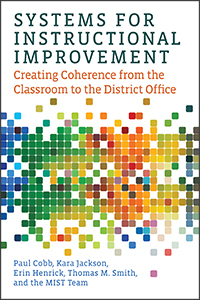 Systems for Instructional Improvement: Creating Coherence from the Classroom to the District Office
Systems for Instructional Improvement: Creating Coherence from the Classroom to the District Office
by Paul Cobb, Kara Jackson, Erin Henrick, Thomas M. Smith and
the MIST Team, Harvard Education Press, Cambridge, Mass., 2018, 320 pp. with index, $33 softcover
Systems for Instructional Improvement, written by researchers from the Middle School Mathematics and the Institutional Setting of Teaching (MIST) project, provides a comprehensive framework for instructional improvements throughout a district. Although focusing on math, the findings are applicable to improvements made in any instructional area.
While districts often focus on one strategy for improvement — professional learning, curriculum, coaching, interventions or instructional materials — the text advocates for a system where each of these strategies work cohesively to ensure improvement. The authors report on research done in four districts that support their assertions and provide evidence that each factor is important for success, as well as what characteristics of each strategy result in favorable outcomes.
The book provides central office teams with substantial fodder for evaluating their own efforts for improving teaching and learning in their district and for finding gaps in the structures and supports in place for improvement efforts.
The rich empirical evidence provided throughout the text can sometimes be daunting to the pragmatic instructional leader who may be looking for simple answers to complex issues. Readers are encouraged to consume every morsel of the rich text in order to appreciate the requisite need for these strategies to work in concert with one another, rather than in isolation.
Reviewed by Judy Paolucci, superintendent of Smithfield Public Schools, Smithfield, R.I.
Why I Wrote this Book ...
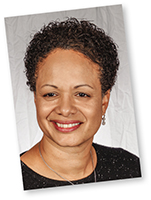
“Too often, we see the collective energy and excitement that surrounds the beginnings of a superintendency derailed by a lack of targeted attention by both the board and the incoming superintendent to questions that must be immediately answered even though the actual event is a year away: How will the superintendent be evaluated, and what are the agreed upon, measurable and evidentiary indicators of efficacious performance that will ultimately anchor the evaluation process? … This book posits that the superintendent’s evaluation is the school board’s vehicle to critically improve the superintendent’s capacity to increase learning outcomes for all students.”
Constance D. Evelyn, superintendent, Valley Stream, N.Y., and AASA member since 2015, on co-authoring (with Jarett Powers)
Evaluating the Superintendent: The Process with Collaborative Compromises and Critical Considerations (Rowman & Littlefield, 2019)
Social Justice
For his doctoral dissertation at Loyola Marymount University, Matthew Hill wanted to learn how superintendents define social justice and implement social justice tenets in their school districts. He interviewed eight superintendents in Los Angeles County.
The findings identified a need for expanding upon current frameworks used for principals in their schools. Hill said no comprehensive body of research exists on superintendents who focus on social justice issues.
Copies of “Social Justice and the Superintendency: A Study of Eight Los Angeles County Superintendents” are available
disspub@proquest.com or 800-521-0600.
BITS & PIECES
Financial Literacy
Discover and Discovery Education have launched a
free financial literacy curriculum for educators that provides step-by-step navigation and learning activities that will equip middle and high school students with skills and habits.
Test Anxiety
An important factor in reducing test anxiety is increasing a student’s sense of being in control, according to a
study published in
School Psychology Quarterly.
Publication Honors
The National School Public Relations Association honored both
School Administrator magazine and
Conference Daily Online with the Award of Excellence, the top award, in the 2019 Publications and Digital Media Awards program.
Two issues of the magazine (
August 2018 on youth apprenticeships and
February 2019 on student mental health) were recognized. The
2019 edition of the national conference publication, produced over four consecutive days in Los Angeles in February, was honored in the electronic newsletter category.
AASA submitted entries only in the two categories in which it earned top honors. NSPRA received 1,148 contest entries.
Kindness Challenge
AASA is a lead partner in the
Middle School Kindness Challenge spearheaded by Stand for Children. It offers a free school climate tool with lessons on four pathways, including strengthening peer relationships and spreading kindness through online communication.